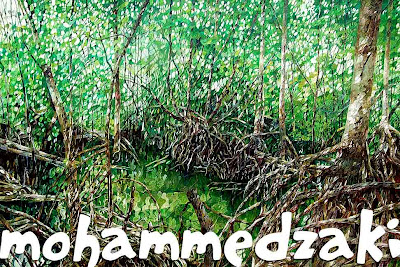Bruguiera adalah species Pohon Bakau. Ia merupakan jenis terbesar dalam keluarga Rhizophoraceae yang terdiri dari 6 spesies. Semua Bruguiera yang dijelaskan di sini adalah yang tumbuh di Pasifik, dengan pengecualian Bruguiera Exaristata yang ditemui di Australia Utara dan New Guinea Selatan, lima jenis Bruguiera selebihnya dapat ditemui di Malaysia dan empat spesies Bruguiera sebelumnya tercatat di Singapura. Bruguiera adalah spesies yang besar. Berdasarkan ukuran bunga dan ejen pendebungaan, berbagai penulis membahagikan Bruguiera umumnya menjadi dua kelompok. Bunganya yang terbengkok ke bawah dianggap didebungakan oleh burung, manakala dua spesies lainnya secara bandingan lebih kecil dan tegak keadaan bunganya mungkin didebungakan oleh serangga. Rencana tahun 2003 mengenai pohon Bakau, menyinari masalah abadi yang utama iaitu terdapat lima spesies Pohon Bakau Bruguiera di Malaysia, terutamanya melalui contoh herbarium kering. Sebagai pengenalan masaalah yang terkait dengan jenis Bruguiera yang tidak terduga sebelumnya bahwa sebagai ahli botani, seperti Watson (1928), Symington (1940) dan Wyatt-Smith (1953) telah mengalami kesulitan yang sama. Di Singapura, maklumat tentang Bruguiera Sexangula sangat terbatas, dan tidak ada catatan diketahui mengenai setiap kelopak bunga Bruguiera Hainesii disegi sifat, bentuk dan benih yang tersedia di bekas kawasan Bruguiera Sexangula. Menurut apa yang terdapat pada Bruguiera Sexangula dianggap spesies pohon Bakau telah punah karena tidak pernah terlihat di alam liarnya selama 50 tahun terakhir. Berdasarkan petunjuk botanikal melalui sifat tumbuh dan subur sebagai ciri yang membezakan, telah ditemui 5 spesies Bruguiera yang wujud.
This article is in Malay language.
 |
genre: nature title: pohon bakau #2 medium: oil painting on canvas size: 91cm x 137cm year: 2009 price: myr 12,000.00 |
"Bruguiera species, distributed all over the Indo-Pacific, provide a number of useful drugs. The scraped skin of the fruit is sometimes applied to stop bleeding and the fruit extract of some species is considered an ophthalmic remedy. The bark is sometimes used as a cooking spice. Essences made by squeezing the pneumatophores are prized as scents by Asian women. Another remarkable medical use is reported from India where leaves of Bruguiera are prescribed to control blood pressure. The traditional medicine of Fiji Islanders includes many curative applications of mangroves. One notion is that the smoke of Excoecaria bark accelerates the healing of leprosy. Another mangrove (Cerbera) is believed to alleviate toothache when mashed leaves are stuffed into dental cavities. In various countries in Southeast Asia the kernels and bark of the same mangrove provide oil extracts which are applied medicinally. The sap of Cerbera serves as a purgative and haemostat, while rubbing the limbs with the fruit extract is said to bring relief from rheumatic pains. Extracts from Rhizophora propagules or from leaves of Acrostichum ferns can also be applied to stop bleeding. In cases of sore throat and stomatitis people of the Pacific coast of Colombia prepare a gargle from bark infusions of the red mangrove (Rhizophora mangle). In Indonesia and Thailand people believe that extracts of Heritiera seeds or Ceriops bark ameliorate attacks of malaria fever. Rural households in southern Thailand often fuel their small lanterns with oil extracted from the cannonball-shaped Xylocarpus fruit. In Indonesia the oil serves as a pomade and, mixed with rice flour, as a face mask. This yellow mixture is also used as a cure for acne. Some Asians use it as a mosquito repellent. In the Philippines, fruit extracts are also employed to treat insect bites and dysenteric fever". For more articles about the mangroves refer to the book titled "MANGROVES the forgotten forest between land and sea", written by Michael Mastaller.
